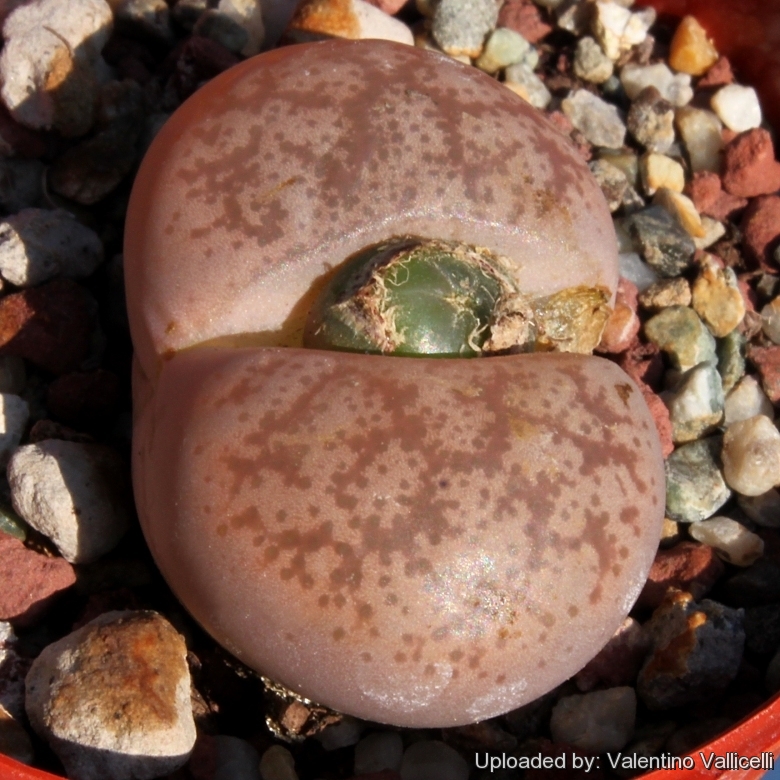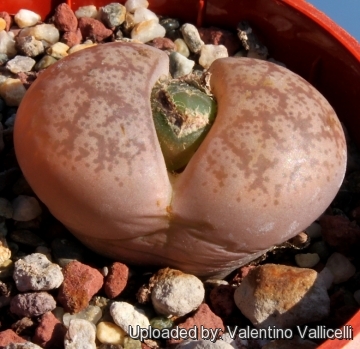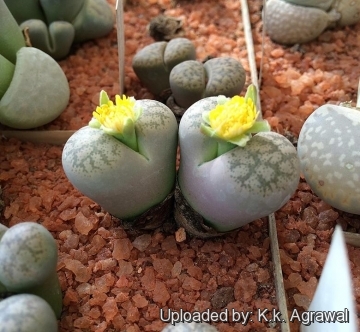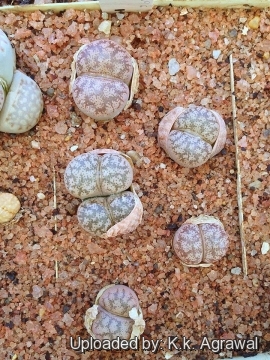




Your support is critical to our success.

SH1500 TL near Ellisras
Origin and Habitat: Endemic to Lephalale, Limpopo province, South Africa.
Habitat: It grows wedged among sandstone rubble and rounded alluvial quartzite pebbles on an eroding conglomerate hillock in the Savanna. Soil rather sandy, beige in colour; depth of soil very shallow, as little as 20 mm in someplaces. The only known population is limited to only 400-500 mature individuals occurring at a single location where it is potentially threatened by collecting for the specialist succulent horticultural trade. Background colours light brown to yellowish, also shades of red, brown, pink, opaque white, purplish, stained black, greenish.
Synonyms:
- Lithops coleorum S.A.Hammer & R.Uijs
Lithops coleorum S.A.Hammer & R.Uijs
Aloe 31(2): 36 (1994)
Synonymy: 2
- Lithops coleorum S.A.Hammer & R.Uijs
- Lithops coleorum C396 TL: Near Ellisras, South Africa
Description: Lithops coleorumSN|13128]]SN|13604]] is tiny species with pale creamy brown bodies suffused with pink or green with distinctive branched markings which make it easy to identify.
Similar species: Somewhat similar to Lithops pseudotruncatellaSN|13604]]SN|13128]] and its allies, but differentiated by its total lack of rubrications and different seed and capsule shape.
Habit: It is an acaulescent perennial, geophytic, succulent, seldom solitary, usually forming clumps of 2, occasionally with up 8 heads.
Bodies (Paired leaves): Small sized, compact, obconic, truncate-cordate in profile, 14-18(-21) mm long, 8-12(-14) mm broad, fissure shallow 3 to 5 mm deep. The lobes are usually unequal. Faces flush or convex and more or less elliptical not translucent and smooth pale pink, grey or greyish-pink, beige or greyish yellow. Shoulders similar to the islands or slightly paler. The margins are not clearly definite and irregularly interrupted by numerous branched intrusions from the channels. The windows are usually not pronounced and often identified as broad to narrow, very irregularly shaped channels and irregularly found more or less crowded on the entire surface including the margins, islands and channels. They are dark green and clearly distinguishable. Channels narrow, semitranslucent, brown with a reddish or rarely greenish cast, usually up to 2,5 mm wide. The islands are small to large opaque areas not sharply definite and irregular. Rubrication absent.
Flowers: Daisy-like, diurnal, small to medium-sized up to 25 mm in diameter (but usually about 20 mm), yellow.
Fruits: Capsules mostly 6-chambered up to 7,5 × 6,5 mm, boat-shaped in profile and the top more or less flat. The end face is elliptic to almost round.
Seeds: Smooth, yellow-brown in colour and with a brown top.
Subspecies, varieties, forms and cultivars of plants belonging to the Lithops coleorum group
 Lithops coleorum S.A.Hammer & R.Uijs: has tiny pale creamy brown bodies suffused with pink or green with distinctive branched markings which make it easy to identify. Distribution: Near Ellisras, Lephalale, Limpopo province, South Africa.
Lithops coleorum S.A.Hammer & R.Uijs: has tiny pale creamy brown bodies suffused with pink or green with distinctive branched markings which make it easy to identify. Distribution: Near Ellisras, Lephalale, Limpopo province, South Africa. Lithops coleorum C396 TL: Near Ellisras, South Africa: tiny spotted body.
Lithops coleorum C396 TL: Near Ellisras, South Africa: tiny spotted body.
Bibliography: Major references and further lectures
1) S.A. Hammer & R. Uijs “Lithops coleorum S.A. Hammer & R. Uijs sp. nov., a new species of Lithops N.E.Br, from the Northern Transvaal.” Aloe 31(2): 36-38 1994
2) Hilton-Taylor, C. 1996. "Red data list of southern African plants." Strelitzia 4. South African National Botanical Institute, Pretoria.
3) Raimondo, D., von Staden, L., Foden, W., Victor, J.E., Helme, N.A., Turner, R.C., Kamundi, D.A. and Manyama, P.A. 2009. "Red List of South African Plants." Strelitzia 25. South African National Biodiversity Institute, Pretoria.
4) Victor, J.E., von Staden, L. & Cole, D.T. 2005. "Lithops coleorum S.A.Hammer & Uijs. National Assessment: Red List of South African Plants" version 2013.1. Accessed on 2013/09/14
5) Heidrun E. K. Hartmann “Aizoaceae F – Z” Springer 2002
6) Achim Hecktheuer “Mesembs, mehr als nur Lithops” Books on Demand GmbH Norderstedt. 2008
7) Desmond T. Cole & Naureen A. Cole, Uwe Beyer, Yves Delange “Les Lithops” SUCCULENTES Spécial 2008 AIAPS (now Terra seca). 2008
8) Desmond T. Cole & Naureen A. Cole “LITHOPS Flowering Stones” Cactus & Co. Libri. 2005
9) Yasuhiko Shimada “The Genus Lithops” Dobun Shoin. 2001
10) Bernd Schlösser “Lithops – Lebende Steine” Praktische Anleitung für die Zimmerkultur. BussinessPoint MEDIA. 2000
11) Steven A. Hammer “Lithops – Treasures of the veld” British Cactus and Succulent Society. 1999
12) Steven A. Hammer "Lithops: Joyaux du veld" Editions Quae, 25/nov/2010
13) Doreen Court “Succulent Flora of Southern Africa” Struik Nature, 2010

Lithops coleorum Photo by: Valentino Vallicelli

Lithops coleorum Photo by: K.k. Agrawal

Lithops coleorum Photo by: K.k. Agrawal
The gallery now contains thousands of pictures, however it is possible to do even more. We are, of course, seeking photos of species not yet shown in the gallery but not only that, we are also looking for better pictures than those already present. Read More...
Cultivation and Propagation: The Lithops (a.k.a. Living Stones) are some of the world's most fascinating plants and are sought by the collector of succulent plants. Paying attention to the particular growing requirement of Lithops is especially important. If you provide the Lithops with the right conditions, they will reward you with their unique shape, size, colour and a proliferation of blooms in autumn. However, Lithops are tricky plants that are very particular about their growing conditions and require the right maintenance in order to keep happy. But don't be afraid even the best growers have plants that mysteriously dry up, or leave during the night. While Lithops are picky about their care, if you are patient and remember the basics, your efforts will be rewarded. Being small plants, a representative collection can be grown on a patio table, a sunny windowsill or a shelf in the greenhouse.
Growing rate: Slow growing for a mesemb.
Soil: They grow best in an open mineral, sandy-gritty soil and requires good drainage as they are prone to root rot. They can grow outdoor in sunny, dry, rock crevices (protection against winter wet is required) They can also be cultivated in alpine house, in poor, drained soil.
Repotting: They may stay in the same pot for many years. Plants grown in larger containers have frequently relatively poor flowers. Flowers might improve when the plants are given their own, small individual pots.
Watering They Require little water otherwise the epidermis breaks (resulting in unsightly scars). The basic cultivation routine is: Stop watering after flowering. Start watering after the old leaves are completely dry (usually late March or Early April). Water freely during the growing season, soak the compost fully but allow it to dry out between waterings. In the winter season the plant doesn’t need watering, the plant in this time extracts water from the outer succulent leaves, allowing them to shrivel away, relocating water to the rest of the plant and to the new leaves that form during this period. If grown in a container, bottom watering by immersing the container is recommended. Water sparingly only when warm, no water when cold. Nearly all problems occur as a result of overwatering and poor ventilation, especially when weather conditions are dull and cool or very humid. They must have very dry atmosphere.
Fertilization: Feed them once during the growing season with a fertilizer specifically formulated for cactus and succulents (high potash fertilizer with a dilute low nitrogen), including all micro nutrients and trace elements diluted to ½ the strength recommended on the label. They thrive in poor soils and need a limited supplies of fertilizer to avoid the plants developing excess vegetation, which is easily attacked by fungal diseases. Some growers fertilize frequently, some hardly ever. However, for the highly succulent mesembs, (Lithops, Conophytums, etc.) fertilization is not really necessary.
Light: They prefer a very bright situation and in winter they need the maximum amount of light you are able to give them, but keep more cool and partially shaded in summer. The only exception to this is seedlings in their first year that enjoy a shades place. Such tiny plants can easily get scorched or broiled and their appearance spoiled (this may not matter in the wild, where the Lithops have probably shrunk into the ground and becomes covered with sands). Outdoor (Lithops prefer full sun, with some shade in the hottest summer months. High levels of light are needed in autumn to flower and for good plant development. The low intensity of sun light during the growing season of this species generally prevents the white flower flowers from opening.
Special Advice: Lithops are best planted in a sunny and airy part of the greenhouse, and not too close to the glass roof or sides of the house as the plants can overheat during hot spells.
Hardiness: They require a minimum temperature 5°C (But will take a light frost and are hardy down to -7° C for short periods if they are in dry soil). USDA zones 9A – 11.
Uses: Container, rock garden.
Pests & diseases: Lithops may be attractive to a variety of insects, but plants in good condition should be nearly pest-free, particularly if they are grown in a mineral potting-mix, with good exposure and ventilation. Nonetheless, there are several pests to watch for:
- Red spiders: they may be effectively rubbed up by misting the vulnerable plants every day.
- Mealy bugs: occasianlly they develop aerial into the new leaves and flowers with disfiguring results, but the worst types develop underground on the roots and are invisible except by their effects.
- Sciara Flies: they are one of the major problems for seedlings. It is a good practice to mulch your seedlings with a layer of grit, which will strongly discourage the flies.
- Scales, thrips and aphids: (they are rarely a problem.)
It is wise to treat your whole collection with a systemic insecticide twice a year in spring and autumn.
- Rot: it is only a minor problem with mesembs if the plants are watered and “aired” correctly. If they are not, fungicides won't help all that much.
Remarks: After flowering in the autumn and extending through winter season the plant doesn’t need watering, but they will still be growing, the new bodies will be increasing in size extracting water from the outer succulent leaves, allowing them to shrivel away. In fact the plant in this time extracts water and nutrient stored in the outer succulent leaves, allowing them to dehydrate relocating the water to the rest of the plant and to the new leaves that form during this period until the old leaves are reduced to nothing more than "thin papery shells".
Propagation: Seed or (or rarely) cuttings. The small seeds can be sown in pots of fine, well-drained sand, any time during the spring and summer months when temperatures are warm. Cover the seeds with a very fine layer of grit and water from below with a fungicide to prevent damping off. For the first 3-4 days cover the pots with a sheet of glass/clear perspex to keep the humidity levels high. Remove the glass and replace it with light shadecloth and mist once or twice a day for the next two weeks after which most seeds should have germinated. From then on mistings can be reduced to every second and then every third day as the little plants grow. Take the cuttings from a grown-up mother plant. Each cutting must contain one or more heads along with a fraction of root and permit them to dry out a couple of days, lay the cuttings on the soil and insert the stem end partially into the soil. Try to keep the cutting somewhat upright so that the roots are able to grow downward. It is relatively difficult to root Lithops from cuttings and generally pointless as well, so quick are they from seed.
Comment: Improvement of Lithops characteristics: Some growers (but not all!!) think it is very intriguing to reinforce any characteristic of cultivated Lithops of by crossing two similar selected plants and then back-crossing with the mother plant. This way we can eventually get some interesting results. Of course, many of the nicest Lithops we grow in cultivation have already been selected over time. However many Lithops are already nice plants which can’t really be improved, on the other hand one could try to improve the colour or the markings etc. Now if we have two particular plants we may attempt to breed between them and can maybe get a whole improved population and then select some better offspring to continue the selection.
Seed production: Plants can be hand pollinated, using a small paint brush. Remember always to cross different clones as the plants are self-sterile. The seed will remain viable for many years provided it is stored in a cool dry place.
| Your Actions | |
|---|---|
| Back to Lithops index | |
| Back to Aizoaceae index | |
 |
Back to Succulents Encyclopedia index |
Privacy stantement - Terms and conditions - How to cite - About us - Feedback - Donate




